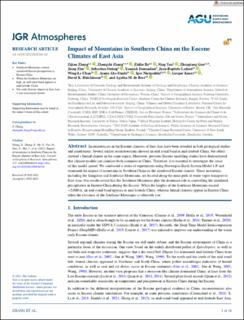| dc.contributor.author | Zhang, Zijian | |
| dc.contributor.author | Zhang, Zhongshi | |
| dc.contributor.author | He, Zhilin | |
| dc.contributor.author | Tan, Ning | |
| dc.contributor.author | Guo, Zhengtang | |
| dc.contributor.author | Zhu, Jiang | |
| dc.contributor.author | Steinig, Sebastian | |
| dc.contributor.author | Donnadieu, Yannick | |
| dc.contributor.author | Ladant, Jean-Baptiste | |
| dc.contributor.author | Chan, Wing-Le | |
| dc.contributor.author | Abe-Ouchi, Ayako | |
| dc.contributor.author | Niezgodzki, Igor | |
| dc.contributor.author | Knorr, Gregor | |
| dc.contributor.author | Hutchinson, David K. | |
| dc.contributor.author | de Boer, Agatha M. | |
| dc.date.accessioned | 2023-09-20T07:28:41Z | |
| dc.date.available | 2023-09-20T07:28:41Z | |
| dc.date.created | 2022-09-30T10:40:56Z | |
| dc.date.issued | 2022 | |
| dc.identifier.citation | Journal of Geophysical Research (JGR): Atmospheres. 2022, 127 (17), . | en_US |
| dc.identifier.issn | 2169-897X | |
| dc.identifier.uri | https://hdl.handle.net/11250/3090654 | |
| dc.description.abstract | Inconsistencies in the Eocene climates of East Asia have been revealed in both geological studies and simulations. Several earlier reconstructions showed an arid zonal band in mid-latitude China, but others showed a humid climate in the same region. Moreover, previous Eocene modeling studies have demonstrated that climate models can simulate both scenarios in China. Therefore, it is essential to investigate the cause of this model spread. We conducted a series of experiments using Norwegian Earth System Model 1-F and examined the impact of mountains in Southern China on the simulated Eocene climate. These mountains, including the Gangdese and Southeast Mountains, are located along the main path of water vapor transport to East Asia. Our results reveal that the Southeast Mountains play the dominant role in controlling the simulated precipitation in Eastern China during the Eocene. When the heights of the Southeast Mountains exceed ∼2,000 m, an arid zonal band appears in mid-latitude China, whereas humid climates appear in Eastern China when the elevation of the Southeast Mountains is relatively low. | en_US |
| dc.language.iso | eng | en_US |
| dc.rights | Navngivelse 4.0 Internasjonal | * |
| dc.rights.uri | http://creativecommons.org/licenses/by/4.0/deed.no | * |
| dc.title | Impact of Mountains in Southern China on the Eocene Climates of East Asia | en_US |
| dc.title.alternative | Impact of Mountains in Southern China on the Eocene Climates of East Asia | en_US |
| dc.type | Peer reviewed | en_US |
| dc.type | Journal article | en_US |
| dc.rights.holder | © 2022. The Authors | en_US |
| dc.description.version | publishedVersion | en_US |
| cristin.ispublished | true | |
| cristin.fulltext | original | |
| cristin.qualitycode | 2 | |
| dc.identifier.doi | 10.1029/2022JD036510 | |
| dc.identifier.cristin | 2057083 | |
| dc.source.journal | Journal of Geophysical Research (JGR): Atmospheres | en_US |
| dc.source.volume | 127 | en_US |
| dc.source.issue | 17 | en_US |
| dc.source.pagenumber | 18 | en_US |
| dc.relation.project | Andre: Swedish Research Council 2018-05973 | en_US |
| dc.relation.project | Andre: Swedish Research Council 2016-03912 and 2020-04791 | en_US |
| dc.relation.project | Norges forskningsråd: 221712, 229819, and 262618 | en_US |
| dc.relation.project | Andre: National NSF of China 41888101, 42125502, and 42007398 | en_US |
| dc.relation.project | Andre: Australian Research Council grant DE220100279 | en_US |

